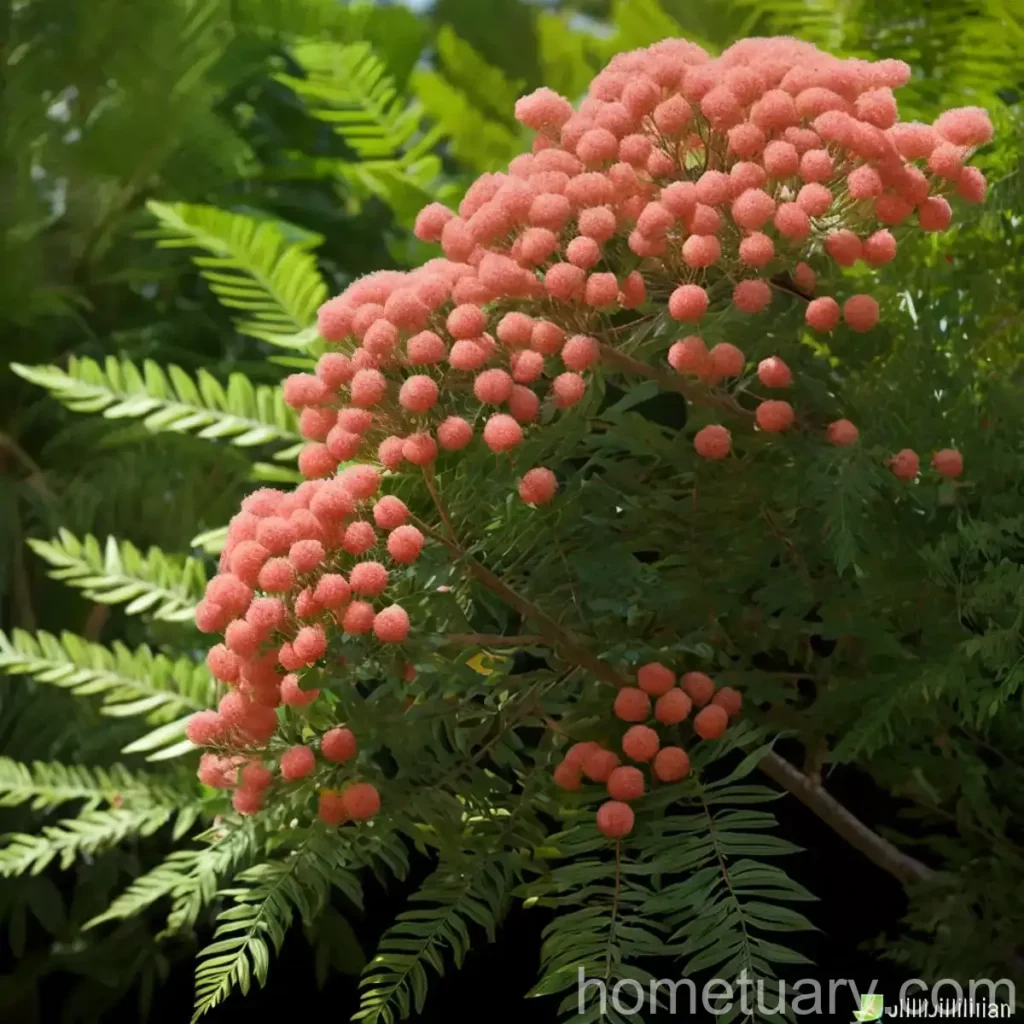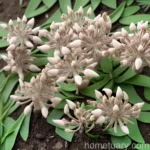Plant Spotlight: Mimosa (Albizia julibrissin ‘Summer Chocolate’)
In the world of ornamental trees, the mimosa (Albizia julibrissin ‘Summer Chocolate’) stands out with its unique characteristics, stunning appearance, and versatility. This deciduous tree, also known as the silk tree, is cherished for its delicate pink flowers, feathery foliage, and its ability to thrive in various landscapes. In this comprehensive guide, we will explore the various aspects of cultivating and caring for the mimosa, including its cultural requirements, common uses, propagation methods, potential diseases and pests, as well as some fascinating facts about this captivating plant.

Key Takeaways
Before delving into the specifics of cultivating and maintaining the ‘Summer Chocolate’ mimosa, let’s summarize some of the key takeaways regarding this remarkable plant:
- Plant Name: Albizia julibrissin ‘Summer Chocolate’
- Other Names: Summer Chocolate Mimosa, Chocolate Mimosa, Silk Tree
- Type: Ornamental Deciduous Tree
- Flowering: Pink Flowers
- Foliage: Feathery, Exotic-Looking Leaves
- Uses: Landscaping, Shade Tree, Specimen Tree
- Adaptability: Drought-Tolerant, Suitable for Various Soil Types
- Challenges: Susceptible to Certain Diseases and Pests
- Growth Rate: Fast-Growing
Culture
Water
The mimosa tree, Albizia julibrissin ‘Summer Chocolate’, generally prefers moderate water supply. It tends to thrive in well-draining soil and should be watered regularly, especially during its establishment phase. However, it is essential to avoid waterlogging, as overly moist conditions can lead to root rot and other complications.
Sunlight
As a sun-loving species, the ‘Summer Chocolate’ mimosa flourishes in full sun exposure. Positioning it in an area that receives at least 6 hours of direct sunlight daily will promote healthy growth and abundant flowering.
Fertilizer
During the growing season, applying a balanced fertilizer can contribute to the overall vigor and blooming performance of the mimosa tree. A slow-release fertilizer formulated for trees and shrubs can be applied in spring to support its development.
Soil
The mimosa tree is adaptable to various soil conditions, but it thrives best in well-draining, slightly acidic soil. While it can tolerate some drought once established, it is crucial to provide adequate moisture during periods of prolonged dryness.
Pruning
Pruning plays a vital role in shaping the mimosa tree and promoting its overall health. Regular pruning can assist in maintaining its desired form, improving air circulation, and removing dead or diseased branches. However, it’s essential to avoid excessive pruning, as the mimosa tree has a tendency to produce vigorous regrowth.
Propagation
The ‘Summer Chocolate’ mimosa can be propagated through several methods, including seed propagation, softwood cuttings, and root cuttings. Each technique has its own set of requirements and timelines, but when executed successfully, they can produce new, healthy plants.
Seed Propagation
Propagation through seeds involves collecting mature seed pods from the tree and sowing the seeds in a suitable growing medium. Adequate moisture and warmth are essential for germination, and with proper care, new mimosa seedlings will emerge.
Softwood Cuttings
Softwood cuttings, taken from the current season’s growth, can be rooted in a favorable medium to initiate new plants. This method requires precise timing and optimal environmental conditions to encourage the development of roots.
Root Cuttings
Root cuttings involve harvesting sections of the tree’s roots and coaxing them to produce new shoots. This process demands patience and attentiveness to ensure the successful establishment of new mimosa plants.
Container Popularity
The ‘Summer Chocolate’ mimosa is also well-suited for container cultivation, making it a desirable choice for individuals with limited outdoor space. When grown in containers, it can be placed on patios, in courtyards, or on balconies, adding a touch of elegance and natural beauty to urban settings. Additionally, it can be a valuable option for those who wish to bring a tropical or exotic element to their outdoor spaces, as the mimosa tree’s distinctive characteristics can create a striking focal point in container gardens.
Common Diseases
While the ‘Summer Chocolate’ mimosa is a resilient and adaptable plant, it is susceptible to certain diseases, including:
- Fusarium Wilt: A soil-borne fungal disease that can cause wilting, yellowing of leaves, and eventual death of the affected tree.
- Verticillium Wilt: Another fungal disease that affects the vascular system of the tree, leading to wilting, leaf discoloration, and decline in overall health.
- Albizia Wilt: A condition specific to Albizia species, characterized by the rapid onset of wilting and browning of foliage, often resulting in the sudden collapse of the tree.
Disease Diagnosis
Diagnosing and addressing diseases in the mimosa tree requires careful observation and prompt action. Early signs of wilting, leaf discoloration, or abnormal growth should be thoroughly inspected to determine the underlying cause. Consulting with a plant pathologist or horticultural expert can aid in accurately identifying the specific disease and implementing effective management practices.
Common Pests
In addition to diseases, the ‘Summer Chocolate’ mimosa can also be vulnerable to certain pests, such as:
- Spider Mites: These tiny arachnids can colonize the foliage of the mimosa tree, causing stippling, webbing, and general decline in health.
- Scale Insects: Scale insects can attach themselves to the stems and leaves of the tree, sapping its vital fluids and weakening its overall condition.
Pest Management
Regular monitoring of the mimosa tree is crucial for early detection of pest infestations. Implementing cultural controls, such as maintaining proper hygiene and minimizing stress on the tree, can contribute to its resilience against pests. In cases of severe infestations, targeted treatments with insecticidal soaps or horticultural oils may be necessary to manage the populations of detrimental insects.
Botanist’s Tips
As a plant scientist with a passion for studying and cultivating trees, I have gathered some valuable insights and tips for successfully caring for the ‘Summer Chocolate’ mimosa:
- Optimal Growing Conditions: Providing well-draining soil, ample sunlight, and consistent moisture are key factors in promoting the healthy growth and development of the mimosa tree.
- Vigilant Monitoring: Regularly inspecting the tree for signs of diseases, pests, or nutrient deficiencies can aid in addressing issues at their early stages and preventing potential complications.
- Pruning Techniques: When pruning the mimosa tree, it is important to use sharp, clean tools, and to avoid over-pruning, as excessive removal of foliage and branches can stress the tree.
- Balanced Nutrition: Applying a balanced fertilizer in spring, in accordance with the specific requirements of the tree, can support its overall vitality and encourage robust flowering.
Fun Facts
To further appreciate the allure of the ‘Summer Chocolate’ mimosa, here are some fun and intriguing facts about this captivating tree:
- Historical Symbolism: In certain cultures, the mimosa tree is associated with symbolism of femininity, sensitivity, and rejuvenation, owing to its delicate appearance and graceful characteristics.
- Ecological Importance: The flowers of the mimosa tree are a valuable source of nectar for pollinators, including bees and butterflies, contributing to the biodiversity of its surrounding environment.
- Cultural Significance: The mimosa tree is celebrated in horticultural and botanical communities for its ornamental value, as well as its adaptability to diverse climatic conditions and soil types.
As a plant enthusiast, I find the ‘Summer Chocolate’ mimosa to be an enchanting addition to any landscape, offering a harmonious blend of exuberant beauty and resilience.
Links to External Resources
For further exploration of the mimosa tree and related topics, I recommend the following external resources:
- The American Mimosa Society: A comprehensive organization dedicated to the study, preservation, and cultivation of various mimosa species, including educational resources and community involvement.
- Plant Diseases and Disorders – Mimosa: An informative resource addressing common diseases and disorders affecting mimosa trees, providing insights on diagnosis and management strategies.
- Insect Pests of Ornamental Trees and Shrubs: A detailed publication focusing on the identification and management of insect pests that can impact the health and vitality of ornamental trees, including mimosas.
By delving into these resources, enthusiasts and horticulturalists can expand their knowledge and appreciation for the diverse aspects of the ‘Summer Chocolate’ mimosa and its related species.
In conclusion, the ‘Summer Chocolate’ mimosa, a cultivar of Albizia julibrissin, stands as an alluring and versatile addition to gardens and landscapes, captivating observers with its effervescent pink flowers and elegant foliage. While it requires careful attention to its watering, sunlight, and potential pests and diseases, the rewards of nurturing this exquisite tree are boundless. Whether grown in a garden bed or a container, the ‘Summer Chocolate’ mimosa has the potential to enrich outdoor spaces and inspire a sense of natural splendor.
With its endearing characteristics and cultural significance, the ‘Summer Chocolate’ mimosa deserves recognition as a botanical treasure, perpetuating its legacy in horticulture and botanical appreciation.
As always, I encourage fellow plant enthusiasts to embrace the wonders of nature and to cherish the botanical marvels that enhance our lives and surroundings.
So, are you ready to embrace the allure of the ‘Summer Chocolate’ mimosa and welcome its ethereal beauty into your garden?
References:
- Albizia julibrissin ‘Summer Chocolate’
- Summer Chocolate Mimosa
- Albizia julibrissin cultivar
- Mimosa tree
- Silk tree
- Ornamental tree
- Summer Chocolate silk tree
- Deciduous tree
- Flora of Asia
- Landscaping with mimosa
- Pink flowers
- Perennial plant
- Mimosa in gardens
- Drought-tolerant plant
- Shade tree
- Mimosa care
- Albizia julibrissin variety
- Small flowering tree
- Mimosa leaves
- Albizia julibrissin cultivar
- Garden tree
- Planting mimosa
- Albizia julibrissin hybrid
- Chocolate mimosa
- Mimosa tree maintenance
- Summer Chocolate mimosa
- Specimen tree
- Albizia julibrissin species
- Mimosa varieties
- Tropical tree
- Albizia julibrissin ‘Summer Chocolate’ plant
- Mimosa characteristics
- Landscape tree
- Albizia julibrissin cultivar
- Mimosa pruning
- Pink mimosa flowers
- Albizia julibrissin ‘Summer Chocolate’ care
- Mimosa propagation
- Albizia julibrissin ‘Summer Chocolate’ growth
- Growing mimosa
- Albizia julibrissin ‘Summer Chocolate’ leaves
- Mimosa tree diseases
- Albizia julibrissin ‘Summer Chocolate’ landscape
- Mimosa tree problems
- Albizia julibrissin hybrid varieties
- Mimosa tree pests
- Albizia julibrissin ‘Summer Chocolate’ characteristics
- Mimosa tree fertilizer
- Albizia julibrissin ‘Summer Chocolate’ pruning
- Mimosa tree landscaping















